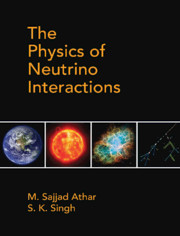Book contents
- Frontmatter
- Dedication
- Contents
- List of Figures
- List of Tables
- Preface
- Acknowledgments
- Chapter 1 Neutrino Properties and Its Interactions
- Chapter 2 Relativistic Particles and Neutrinos
- Chapter 3 Quantization of Free Particle Fields
- Chapter 4 Interacting Fields and Relativistic Perturbation Theory
- Chapter 5 Phenomenological Theory I: Nuclear β-decays and Weak Interaction of Leptons
- Chapter 6 Phenomenological Theory II: Weak Decays of Hadrons
- Chapter 7 Gauge Field Theories and Fundamental Interactions
- Chapter 8 Unified Theory of Electroweak Interactions
- Chapter 9 Neutrino and Electron Scattering from Point Particles
- Chapter 10 Neutrino scattering Cross Sections from Hadrons: Quasielastic Scattering
- Chapter 11 Neutrino Scattering from Hadrons: Inelastic Scattering (I)
- Chapter 12 Neutrino Scattering from Hadrons: Inelastic Scattering (II)
- Chapter 13 Neutrino Scattering from Hadrons: Deep Inelastic Scattering
- Chapter 14 Weak Quasielastic v(⊽)-nucleus Scattering
- Chapter 15 Inelastic Scattering of (Anti)neutrinos from Nuclei
- Chapter 16 Deep Inelastic Scattering of (Anti)neutrinos from Nuclei
- Chapter 17 Neutrino Sources and Detection of Neutrinos
- Chapter 18 Neutrino Mixing and Oscillations
- Chapter 19 Neutrino Astrophysics and the Synthesis of Elements
- Chapter 20 Neutrino Interactions Beyond the Standard Model
- Appendices
- Appendix A Lorentz Transformation and Covariance of the Dirac Equation
- Appendix B Cabibbo Theory
- Appendix C Some Properties of Pauli and Dirac Matrices and Spin Density Matrices
- Appendix D Leptonic and Hadronic Tensors
- Appendix E General Expression for the Total Scattering Cross Section and Decay Rates
- Appendix F Expressions of N(q2), the Coefficients of the Polarization Observables
- References
- Index
Chapter 15 - Inelastic Scattering of (Anti)neutrinos from Nuclei
Published online by Cambridge University Press: 22 May 2020
- Frontmatter
- Dedication
- Contents
- List of Figures
- List of Tables
- Preface
- Acknowledgments
- Chapter 1 Neutrino Properties and Its Interactions
- Chapter 2 Relativistic Particles and Neutrinos
- Chapter 3 Quantization of Free Particle Fields
- Chapter 4 Interacting Fields and Relativistic Perturbation Theory
- Chapter 5 Phenomenological Theory I: Nuclear β-decays and Weak Interaction of Leptons
- Chapter 6 Phenomenological Theory II: Weak Decays of Hadrons
- Chapter 7 Gauge Field Theories and Fundamental Interactions
- Chapter 8 Unified Theory of Electroweak Interactions
- Chapter 9 Neutrino and Electron Scattering from Point Particles
- Chapter 10 Neutrino scattering Cross Sections from Hadrons: Quasielastic Scattering
- Chapter 11 Neutrino Scattering from Hadrons: Inelastic Scattering (I)
- Chapter 12 Neutrino Scattering from Hadrons: Inelastic Scattering (II)
- Chapter 13 Neutrino Scattering from Hadrons: Deep Inelastic Scattering
- Chapter 14 Weak Quasielastic v(⊽)-nucleus Scattering
- Chapter 15 Inelastic Scattering of (Anti)neutrinos from Nuclei
- Chapter 16 Deep Inelastic Scattering of (Anti)neutrinos from Nuclei
- Chapter 17 Neutrino Sources and Detection of Neutrinos
- Chapter 18 Neutrino Mixing and Oscillations
- Chapter 19 Neutrino Astrophysics and the Synthesis of Elements
- Chapter 20 Neutrino Interactions Beyond the Standard Model
- Appendices
- Appendix A Lorentz Transformation and Covariance of the Dirac Equation
- Appendix B Cabibbo Theory
- Appendix C Some Properties of Pauli and Dirac Matrices and Spin Density Matrices
- Appendix D Leptonic and Hadronic Tensors
- Appendix E General Expression for the Total Scattering Cross Section and Decay Rates
- Appendix F Expressions of N(q2), the Coefficients of the Polarization Observables
- References
- Index
Summary
Introduction
We have discussed inelastic processes from free nucleon targets in Chapters11 and 12. However, most of the early experiments and also the newexperiments on inelastic as well as quasielastic reactions induced by(anti)neutrinos use nuclear targets. In this chapter, we will focus on theinelastic process of producing mesons and photons from the nuclear targets.When inelastic processes like
(discussed in Chapter 12) take place inside a nucleus, the nucleus can stayin the ground state giving almost all the transferred energy in the reactionto the outgoing meson leading to the coherent production of mesons or can beexcited and/or broken up leading to the incoherent production of meson. Inthe subsequent sections, incoherent and coherent pion production from nucleiin the delta dominance model will be discussed with some comments on theinelastic production of kaons and photons.
The first experiments on inelastic scattering of (anti)neutrinos from nucleiwere done at CERN in the early 1960s using heavy liquid bubble chambers(HLBC) filled with propane, freon and with spark chambers, and at ANL/BNLwith spark and bubble chambers. The importance of nuclear medium effects inthe analysis of these experiments was realized and discussed in the contextof inelastic as well as quasielastic reactions. Some of the mesons, mostlypions, produced in the inelastic reactions could be absorbed in the parentnucleus giving rise to ‘pionless’ lepton events in chargedcurrent (CC) induced reactions enhancing the yield of quasielastic eventsand reducing the yield of ‘pionic’ events as compared to thetheoretical predictions for these reactions from free nucleon targets(Chapter 12). While some theoretical calculations were made to estimate,quantitatively, the effect of nuclear medium effects in quasielasticreactions (see Chapter 14), no serious efforts were made in the case ofinelastic reactions. Subsequently, many experiments were done at CERN [696,697, 698, 699, 700], SKAT [701, 702, 703, 704], FNAL [705, 706], and CHARM[707], using propane, propane– freon, neon, marble, and aluminiumtargets; only a qualitative description of the nuclear medium effects wasused. Most of these experiments studied the incoherent production of pionswhile some of them also studied the coherent production of pions [698, 699,700, 703, 704, 706, 708, 709] from nuclei.
- Type
- Chapter
- Information
- The Physics of Neutrino Interactions , pp. 603 - 631Publisher: Cambridge University PressPrint publication year: 2020



